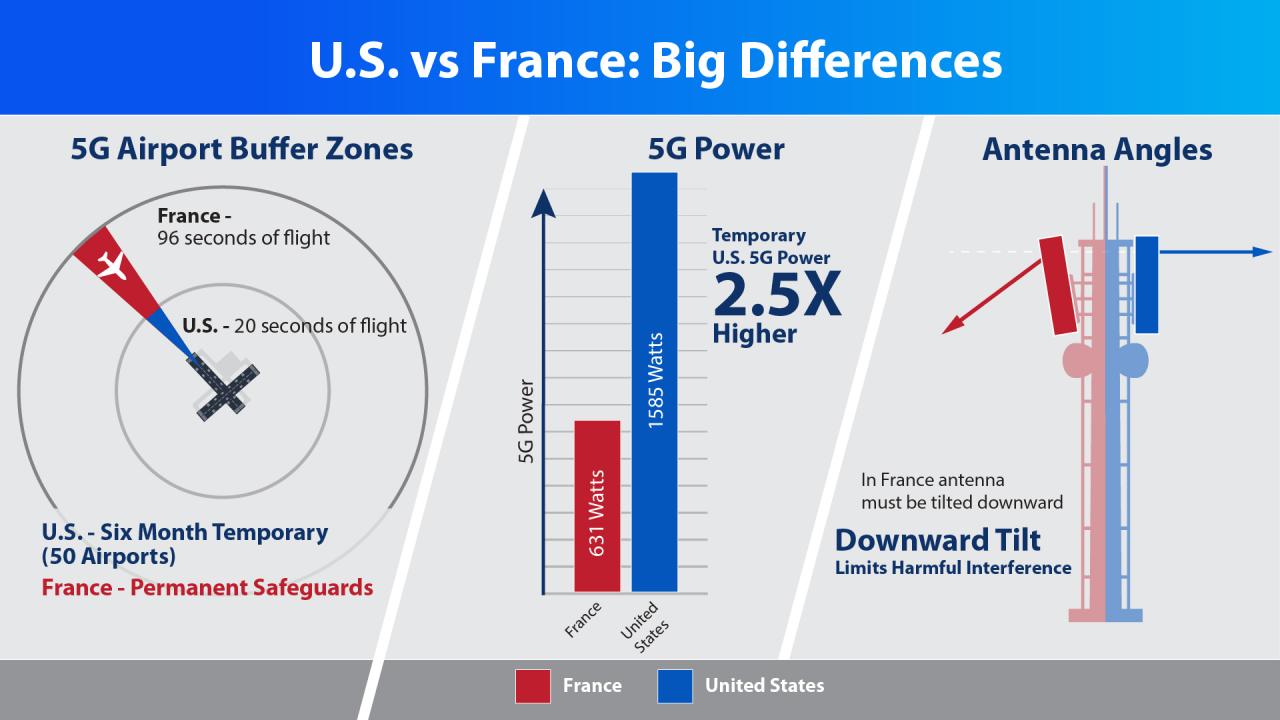FAA Identifies 50 US Airports for New 5G Buffer Zones


An American Airlines aircraft lands at Dallas/Fort Worth International Airport, one of 50 airports identified by the FAA as requiring 5G C-Band “buffer zones.” (Dallas/Fort Worth International Airport)
The FAA on Jan. 7 published a new list of the 50 U.S. airports that will have “buffer zones” around them once 5G C-band services come online later this month.
Identification of the airports is the latest policy update from the agency related to its ongoing efforts to establish a long-term solution that allows new 5G C-band wireless services and flight operations to safely co-exist throughout the National Airspace System (NAS). According to the statement published by the FAA, the list of airports was developed based on input from aviation industry leaders, and the traffic volume, number of low-visibility days on average, and geographic location were all determining factors in developing the list.
“The wireless companies agreed to turn off transmitters and make other adjustments near these airports for six months to minimize potential 5G interference with sensitive aircraft instruments used in low-visibility landings,” the FAA said in a statement published on its website.
Some of the largest and busiest airports in the U.S.—based on the latest available air traffic data—are included in the list. Dallas/Fort Worth International, Chicago O’Hare International, and Los Angeles International were among the airports with the highest amount of traffic listed—with Hartsfield-Jackson Atlanta International Airport being one of the most notable to be left off the list. Airports located in cities where 5G C-Band is not being deployed were left off the list, with the FAA naming Denver International and Ronald Regan Washington National Airport as some examples of areas where the new services are not being deployed.
In an emailed statement to Avionics International, a representative for the FAA said that the buffer zones will follow the guidance outlined by AT&T and Verizon on the fifth page of the letter sent to the agency to negotiate a new agreement.
Based on the guidance provided by the two companies in the letter, the buffer zones include “limit power radiated below the horizon to no more than 62 dBm/MHz” and “to limit radiated power for all of their 5G C-Band base stations directed skyward above the horizon to even lower levels.” Moreover, the buffer zones are three-dimensional, yielding lower measured power levels from 5G C-Band stations on all airport surfaces and up to 300 feet above airports and more than one mile from airport runways.
“AT&T and Verizon also agreed to limit radiated power from 5G base stations to even lower levels when those base stations are located in line with airport runways. This commitment can apply to base stations located as far as 1,000 feet from a runway,” the letter says.
Low visibility landings are still being permitted at the airports included in the list if they’re being performed by aircraft that have “an altimeter that has been proven to be accurate and reliable in the U.S. 5G C-band environment,” according to the FAA.

A new infographic published by the FAA shows the differences in how 5G C-Band has been deployed in France and the U.S. (FAA)
The list comes following several months of ongoing discussions between aviation and wireless industry/government leadership to address concerns raised by the FAA regarding the potential risk of signal interference issues that the operation of 5G C-band services could cause to radar and radio altimeters used by air transport category aircraft. Last week, AT&T and Verizon reached an agreement with the aviation industry to delay the planned Jan. 5 deployment date of its new 5G C-Band wireless network services.
Aircraft radar altimeters operate within 4.2–4.4 GHz, the lower half of which falls within the C-Band—a frequency range from 3.7–4.2 GHz where the combination of the range of signal transmissions and capacity are optimum. The 5G wireless networks scheduled to be switched on by AT&T and Verizon this month will occur within the 3.7–3.98 GHz frequency range, close to the altimeters, which has left aviation industry experts with concerns over signal interference issues. In December, the FAA published new airworthiness directives (ADs) that will prohibit certain types of advanced fixed and rotary wing landing procedures that rely on the use of radar altimeter data.
Separate from the list of identified airports, the FAA also published a new “5G and Aviation Safety” page to its website, providing answers to some of the most frequently asked questions it has been receiving in relation to the deployment of the new 5G networks. Among the answers given are an explanation of the differences between the 5G deployment that has already occurred in France and the mitigation strategy around airports employed by the French government compared to what the FAA is doing in the U.S.
“5G power levels are lower in France. In the U.S., even the planned temporary nationwide lower power levels will be 2.5x higher than in France,” according to the FAA’s new 5G page. “In France, the government required that antenna must be tilted downward to limit harmful interference. Similar restrictions do not apply to the U.S. deployment.”
The post FAA Identifies 50 US Airports for New 5G Buffer Zones appeared first on Aviation Today.
—————
Boost Internet Speed–
Free Business Hosting–
Free Email Account–
Dropcatch–
Free Secure Email–
Secure Email–
Cheap VOIP Calls–
Free Hosting–
Boost Inflight Wifi–
Premium Domains–
Free Domains






